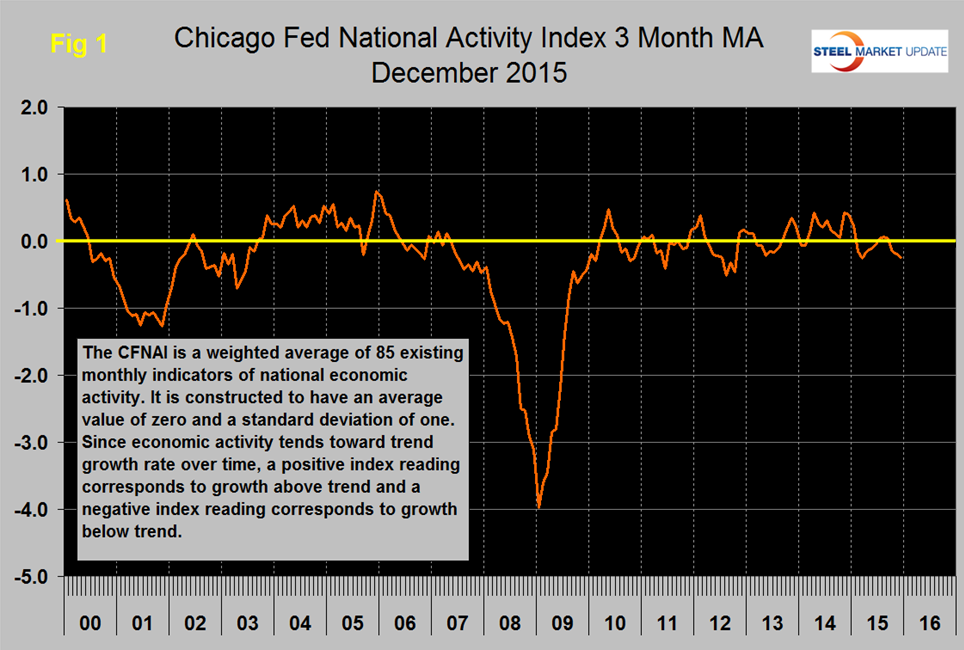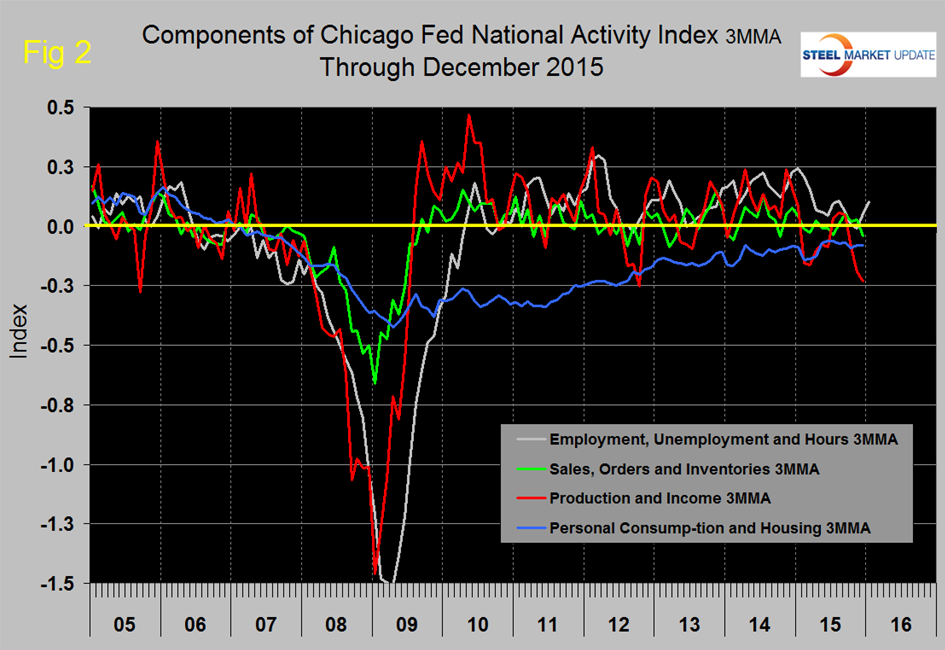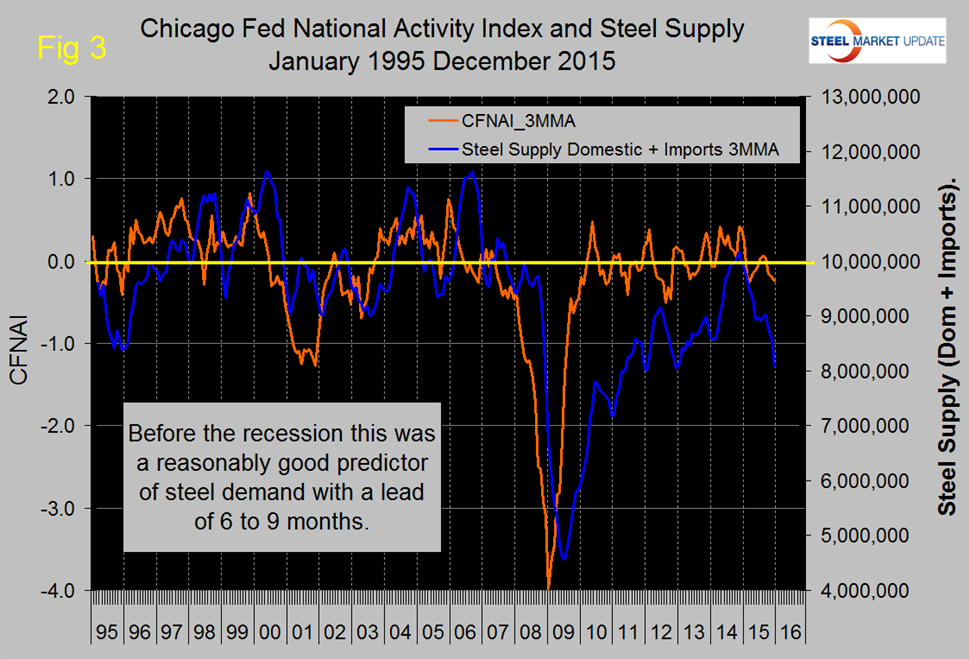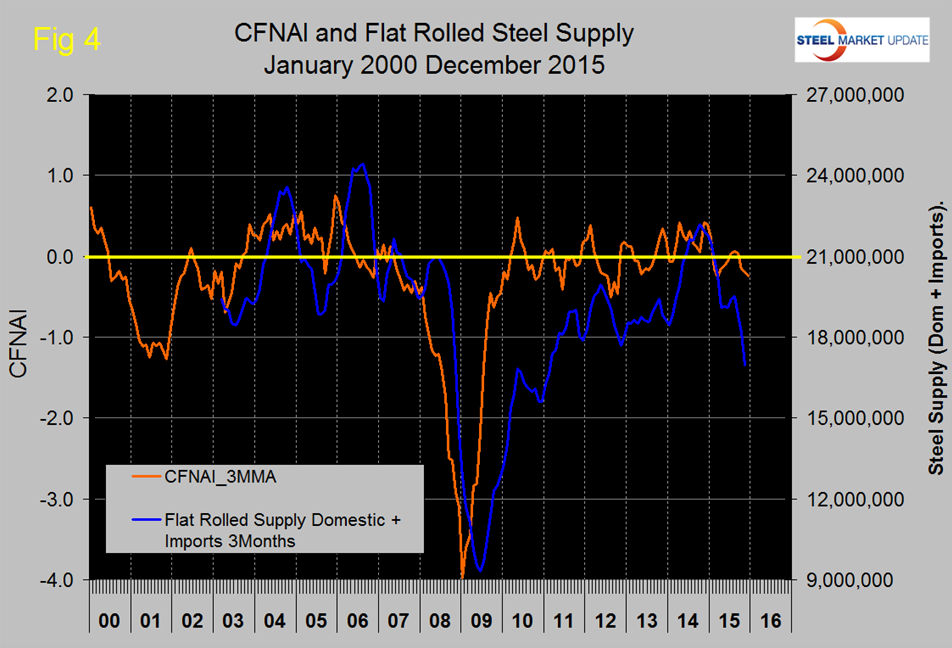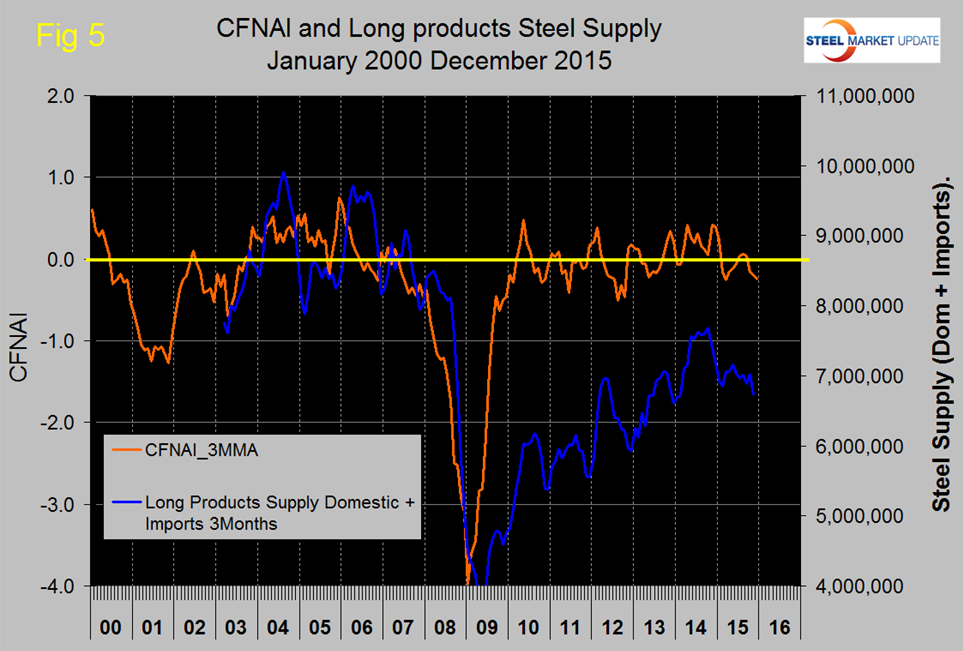Economy

The Chicago Federal Reserve National Activity Index and Steel Supply
Written by Peter Wright
January 26, 2016
The following is the Chicago Federal Reserve statement followed by our own graphical analysis. The CFNAI is an excellent reality check for much of the economic analysis that we routinely provide in The Steel Market Update and is also a reasonably good predictor of the direction of steel demand with a six to nine month lead. For example by the time the steel market went off the cliff in September 2008, the CFNAI had been signaling an increasingly severe problem for eight months. Then in the first Q of 2009 the CFNAI was recovering as steel supply was still going south. An explanation of the Index is provided at the end of this piece.
![]() The official statement reads as follows:
The official statement reads as follows:
Index shows economic growth below average in December
The Chicago Fed National Activity Index (CFNAI) moved up to –0.22 in December from –0.36 in November. Two of the four broad categories of indicators that make up the index increased from November, but three of the four categories made negative contributions to the index in December.
The index’s three-month moving average, CFNAI-MA3, decreased to –0.24 in December from –0.19 in November. December’s CFNAI-MA3 suggests that growth in national economic activity was somewhat below its historical trend. The economic growth reflected in this level of the CFNAI-MA3 suggests subdued inflationary pressure from economic activity over the coming year.
The CFNAI Diffusion Index, which is also a three-month moving average, ticked up to –0.12 in December from –0.13 in November. Thirty-five of the 85 individual indicators made positive contributions to the CFNAI in December, while 50 made negative contributions. Fifty-one indicators improved from November to December, while 32 indicators deteriorated and two were unchanged. Of the indicators that improved, 26 made negative contributions. The contribution from production-related indicators to the CFNAI increased to –0.26 in December from –0.40 in November. Industrial production decreased by 0.4 percent in December after declining by 0.9 percent in November. Moreover, manufacturing production decreased by 0.1 percent in December after decreasing by the same percentage in the previous month. The sales, orders, and inventories category made a contribution of –0.02 to the CFNAI in December, up slightly from –0.03 in November.
The contribution from employment-related indicators to the CFNAI was unchanged at +0.12 in December. Nonfarm payrolls rose by 292,000 in December after increasing by 252,000 in November, and the unemployment rate remained at 5.0 percent in December.
The contribution of the personal consumption and housing category to the CFNAI edged down to –0.07 in December from –0.05 in November. Housing starts decreased to 1,149,000 annualized units in December from 1,179,000 in November. In addition, housing permits moved down to 1,232,000 annualized units in December from 1,282,000 in the previous month.
The CFNAI was constructed using data available as of January 20, 2016. At that time, December data for 49 of the 85 indicators had been published. For all missing data, estimates were used in constructing the index. The November monthly index value was revised to –0.36 from an initial estimate of –0.30. Revisions to the monthly index value can be attributed to two main factors: revisions in previously published data and differences between the estimates of previously unavailable data and subsequently published data. The revision to the November monthly index value was due primarily to the former.
SMU Analysis
The CFNAI declined for three straight months through November then picked back up in December (see explanation below). Figure 1 shows the SMU analysis of the three month moving average (3MMA) through December and that the index was slightly positive each month July through September, declined to negative 0.16 in October, to negative 0.19 in November and negative 0.24 in December.
Figure 2 shows the trends of the four main subcomponents.
There was a gradual five year improvement in personal consumption and housing through mid-2015 but since then this component has lost direction. The other three sub-components continue to be erratic with a strong downward trend in employment and hours worked that picked back up in November and December. There has been a marked drop in production and income in the last three months. If our observations here seem to be at odds with the official statement it is because we discuss only three month moving averages.
Figure 3 compares the 3MMA of steel supply based on AISI data + imports with the CFNAI and shows that the index has historically been a reasonably accurate leading indicator of steel demand (apparent supply) with a lead time of six to nine months.
SMU monitors several benchmark indicators to evaluate whether steel consumption is where it should be based on historical patterns, this is one of them. Total steel supply closed the gap in the period mid 2009 through Q4 2014 but in the last twelve months has fallen off again probably as a result of the depressed energy sector. Figure 4 and Figure 5 show this same relationship for flat rolled and long products separately, based on a rolling three months tonnage for each.
The difference is quite dramatic and qualitatively in agreement with our analysis of steel service center shipments. For long products the supply picture developed from data provided by the Steel Manufacturers Association is very similar. Flat rolled driven mainly by manufacturing came back in line at the end of 2014 but in 2015 fell off dramatically as demand from the energy sector collapsed. Long products driven mainly by construction is still depressed and since the recession has not come anywhere near where this benchmark predicts. Based on the historical lead of the CFNAI it does not look as though total steel demand will pick up through Q1 2016. Note; steel supply shown is only through November as that is the latest data available.
Explanation: The index is a weighted average of 85 indicators of national economic activity drawn from four broad categories of data: 1) production and income; 2) employment, unemployment, and hours; 3) personal consumption and housing; and 4) sales, orders, and inventories. A zero value for the index indicates that the national economy is expanding at its historical trend rate of growth; negative values indicate below-average growth; and positive values indicate above-average growth. When the CFNAI-MA3 (three month moving average) value moves below -0.70 following a period of economic expansion, there is an increasing likelihood that a recession has begun. Conversely, when the CFNAI-MA3 value moves above -0.70 following a period of economic contraction, there is an increasing likelihood that a recession has ended. When the CFNAI-MA3 value moves above +0.70 more than two years into an economic expansion, there is an increasing likelihood that a period of sustained increasing inflation has begun.

Peter Wright
Read more from Peter WrightLatest in Economy

Steel groups welcome passage of budget bill
Steel trade groups praised the passage of the Big Beautiful Bill (BBB) in Congress on Thursday.

Industry groups praise Senate for passing tax and budget bill
The Steel Manufacturers Association and the American Iron and Steel Institute applauded the tax provisions included in the Senate's tax and budget reconciliation bill.

Chicago PMI dips 0.1 points in June
The Chicago Purchasing Managers Index (PMI) slipped 0.1 points to 40.4 points, in June.

Multi-family pullback drives housing starts to 5-year low in May
US housing starts tumbled in May to a five-year low, according to figures recently released by the US Census Bureau.

Architecture firms still struggling, ABI data shows
Architecture firms reported a modest improvement in billings through May, yet business conditions remained soft, according to the latest Architecture Billings Index (ABI) release from the American Institute of Architects (AIA) and Deltek.

